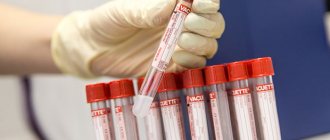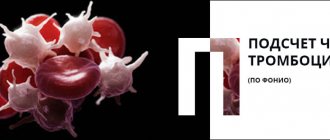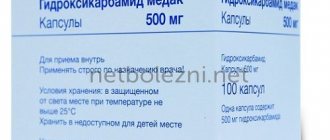What does ESR show in the blood in adults?
Red blood cells are the main cells of the bloodstream and have the ability to “stick together” with other components of the biological fluid - globulins, albumins, etc. When pathogenic microorganisms (mainly bacterial in nature), remnants of damaged cells of internal organs, etc. penetrate into the blood, these particles also “stick together” with red blood cells, making them heavier and the rate of their sedimentation increases.
Thus, the study concludes: if the ESR value in a blood test is normal, then there are no inflammatory processes in the body, and if the indicator is exceeded or decreased, an extended diagnosis should be carried out to determine the etiology of the inflammatory process.
The indicator also has its own characteristics - its parameters depend on the age of the patient.
Determining the normal erythrocyte sedimentation rate makes it possible to identify inflammatory processes in men at the earliest, asymptomatic stages, and this increases the chances of quick and successful treatment. Such an analysis is usually carried out for preventive purposes, for early diagnosis, as well as to evaluate the therapy being carried out - if the ESR level returns to age-related norms, it means that the treatment is producing positive results.
Based on the results of the examination, the ESR level may be normal, increased or decreased. In the first case, we can say that the man is healthy; in the other case, we can look for a disease that led to deterioration in health or establish the physiological causes of such deviations (stress, overwork, a vegetarian diet and etc.).
False-positive ESR tests
In medicine there is also the concept of a false positive analysis. An analysis of ESR is considered such if there are factors on which this value depends:
- anemia (no morphological changes in red blood cells occur);
- increase in the concentration of plasma proteins , with the exception of fibrinogen ;
- hypercholesterolemia;
- renal failure;
- obesity ;
- pregnancy;
- old age of a person;
- administration of dextran ;
- a technically incorrect study;
- taking vitamin A ;
- recent vaccination against hepatitis B.
Table of ESR norms in men by age
For healthy representatives of the stronger sex, the following indicators are accepted, measured in millimeters per hour:
| Age, years | ESR value, mm/hour |
| 15-20 | From 1 to 10 |
| 20-50 | From 2 to 15 |
| 50- | From 2 to 35 |
Why is the ESR rate in the blood of men after 50 years higher than at a young age?
This is explained by the natural processes of aging: organ cells renew themselves more slowly, and destroyed ones that have outlived their usefulness remain in the body longer. This is also facilitated by various chronic diseases that occur in most patients by these years.
Decoding ESR in men
Decoding includes several degrees of deviation:
- I degree – deviations are no more than 1 mm/h, and other clinical indicators correspond to healthy norms;
- II degree – the increase reaches 15-30 mm/h, indicating a minor inflammatory process;
- III degree - an increase in the ESR rate exceeds 30 mm/h, which is a sign of a pronounced inflammatory process;
- IV degree – deviation of ESR in men reaches 50 mm/h, which means that the patient is suffering from an acute form of severe infection. It is also possible to have a malignant neoplasm or an autoimmune lesion of the connective tissue.
Read further: ESR norms in women, deviations and treatment methods
All standards are relative, and in each laboratory they may differ slightly. Therefore, when decoding, you should always focus on the data specified in the research form, i.e. accepted in a specific clinic.
Yu.V. Pervushin, V.V. Velkov*, L.S. Putrenok.**
State Educational Institution of Higher Professional Education Stavropol State Medical Academy of Roszdrav, Department of Clinical Laboratory Diagnostics FPO, *CJSC "DIAKON", Pushchino, Moscow Region, **Stavropol Regional Clinical Diagnostic Center.
Why, doctors, even in modern medical institutions, cannot part with the tradition of determining ESR , despite numerous scientific data that cast doubt on the accuracy and diagnostic value of this test?
Erythrocyte sedimentation rate (ESR, previously erythrocyte sedimentation reaction - (ROE) is a nonspecific laboratory blood indicator; a change in ESR can serve as an indirect sign of a current inflammatory or other pathological process. For more than a hundred years, this test, despite the fact that it is nonspecific, has been used for quantitative characteristics of the severity of inflammatory processes caused by infections, various inflammations, and the development of neoplasms. However, although inflammation is the most common cause of accelerated erythrocyte sedimentation, an increase in ESR can also be caused by other, including not always pathological, conditions. Thus, the results ESR determinations can be considered reliable only when no parameters other than those expected influence the indicator being studied. In fact, too many factors influence the results of this test and therefore its clinical significance should be reconsidered. The main effect is on the erythrocyte sedimentation rate, suspended in plasma, affects the degree of their aggregation. This process is quite complicated. It depends on many factors and the leading role in it belongs to three main ones - those influencing the aggregation of erythrocytes, these are: 1) surface energy of the cells, 2) cell charge and 3) dielectric constant. The latter indicator is a characteristic of plasma associated with the concentration of asymmetric molecules. An increase in the content of such molecules (proteins) leads to an increase in the strength of the bonds between red blood cells, which, in turn, leads to agglutination and clumping (formation of columns) of red blood cells and, thus, to a higher rate of their sedimentation. However, these main factors, in turn, depend on many physicochemical changes occurring in the body (Table 1).
Table 1 The influence of some physicochemical factors on the ESR value (according to G.E. Roitberg and A.V. Strutynsky, 1999)
| Basic physical and chemical factors | The most common pathological changes | Change in ESR |
| Fibrinogen | Increase | Increase |
| α-globulins | Increase | Increase |
| γ-globulins | Increase | Increase |
| Paraproteins | Increase | Increase |
| Albumen | Increase | Increase |
| Bile pigments | Increase | Decrease |
| Bile acids | Increase | Decrease |
| Changes in blood pH | Decrease (acidosis) Increase (alkalosis) | Decrease Increase |
| Blood viscosity | Increase Decrease | Decrease Decrease |
| Red blood cell count | Increase (erythrocytosis) Decrease (anemia) | Decrease Increase |
In addition to these factors, laboratory-methodological, biological and iatrogenic influences can change the ESR indicator (see Table 2).
Table 2 Factors causing an increase in ESR (L.I. Dvoretsky, 1998)
| Laboratory and methodological | Biological | Iatrogenic |
| Inaccurate amount of citrate | Macrocytosis | Dextrans |
| Standing the sample with citrate for more than 4 hours | Anemia | Phenothiazine |
| Standing the sample in the light | Anti-erythrocyte antibodies | a-Methyldopa |
| Keeping the sample warm | Hyperproteinemia | Vitamin A |
| Wet capillary | Dysproteinemia | Contraceptives |
| Standing the sample at an angle | Hyperfibrinogenemia | g-globulin |
| Hyperlipidemia | Deseril | |
| Alkalosis | ||
| Pregnancy | ||
| Elderly age |
What causes false results when measuring ESR?
False increase in ESR - summing up the most common factors and common clinical situations affecting ESR, we can conclude that the clinician most often encounters a false increase in ESR when:
- anemia with normal erythrocyte morphology
- an increase in plasma concentrations of all proteins except fibrinogen, M-protein, macroglobulins and erythrocyte agglutinins
- renal failure
- use of heparin when drawing blood
- hypercholesterolemia
- extreme obesity
- pregnancy (by the way, the determination of ESR was originally used to establish pregnancy)
- female
- elderly age
- technical errors during testing (deviation of the test tube from the vertical position increases the ESR, while an angle of 3° from the vertical line can lead to an increase in ESR by up to 30 units).
A false decrease in ESR can occur when:
- increase in red blood cell count
- significant increase in white blood cell count
- DIC syndrome (due to hypofibrinogenemia)
- dysfibrinogenemia
- afibrinogenemia
- significant increase in the level of bile salts in the blood plasma
- congestive heart failure
- valproic acid
- low molecular weight dextran
- cachexia,
- lactation.
A false decrease in ESR can occur due to morphological changes in red blood cells: red blood cells of an abnormal, unusual shape prevent the formation of columns and lead to a decrease in ESR. This is exactly how they affect erythrocyte aggregation, reducing ESR: 1) spherocytosis, 2) anisocytosis, 3) poikilocytosis. I wonder how to objectively assess what happens in iron deficiency anemia, when a decrease in the number of red blood cells accelerates the ESR, and aniso- and poikilocytosis slow it down, and how to correctly calculate the relative importance of these factors?
The most common technical errors in determining ESR ESR decreases as the temperature in the laboratory decreases; to determine ESR, blood obtained more than 2 hours before the test cannot be used: during storage, red blood cells take on a spherical shape and ESR decreases. It is also believed that the three most common factors that underestimate ESR in patients are: 1) blood thickening, 2) acidosis, 3) hyperbilirubinemia. Based on the above, it should be especially emphasized that for any diseases that are, in principle, characterized by an increase in ESR, this indicator at certain stages of the development of the pathological process may in fact not be increased and lead to erroneous conclusions if at least one of the following factors: 1) blood thickening, 2) a state of acidosis or hyperbilirubinemia (jaundice), 3) cardiac decompensation, 4) a state of ketoacidosis in diabetes mellitus and 4) many other changes in the patient’s body. Thus, it is obvious that doctors who require the determination of ESR rely more on the traditions of medicine than on the actual reliability of this method.
But the doctor urgently needs to assess the severity of the inflammatory reaction. The best method for this assessment is to measure the concentration of C-reactive protein, the main acute phase protein (APP) of inflammation. BOP levels during the inflammatory process change to varying degrees and depending on the stage of inflammation (Fig. 1). Assessing this group of indicators based on the dynamics of BEF levels, the degree of increase in these levels, their specificity, and, finally, the reliability of their laboratory determination, we can clearly name the most “worthy candidate for filling the position” ESR - SRB. Like all BOPs, CRP is synthesized in the liver under the influence of interleukins, oncostatin M, with the modulating effects of other interleukins and tumor necrosis factor. CRP is considered one of the “main” BFs of inflammation in humans, as it increases very quickly (in the first 6-8 hours) and very significantly (20-100 times, sometimes 1,000 times). But is measuring CRP levels really better than measuring ESR? Table 3 compares the results of ESR and CRP measurements, from which it follows that CRP is the most specific and most sensitive qualitative and quantitative laboratory indicator of inflammation and necrosis. CRP concentrations change rapidly in response to increasing or decreasing severity of inflammation. That is why measurement of CRP levels is widely used to monitor and control the effectiveness of therapy for bacterial and viral infections, chronic inflammatory diseases, cancer, complications in surgery and gynecology, etc.
Rice. 1 . Changes in the concentration of BOP during moderate inflammation (Shevchenko O.P., 2005)
CRP levels in various inflammatory processes
Up to 10-30 mg/l – CRP increases with viral infections, tumor metastasis, sluggish chronic and some systemic rheumatic diseases.
to 40-100 mg/l (and sometimes up to 200 mg/l) with: 1) bacterial infections, 2) exacerbation of some chronic inflammatory diseases and 3) tissue damage (surgery, acute myocardial infarction). With effective treatment of bacterial infections, the level of CRP decreases the next day; if not, more effective antibacterial treatment is necessary.
Up to 300 mg/l or more - CRP increases with: 1) severe generalized infections, 2) burns, 3) sepsis, which increase CRP almost prohibitively.
Table 3 What determines changes in ESR and CRP levels (T. Husain, et al. 2001)
| The measurement result depends on: | ESR | SRB |
| Paula | Yes | No |
| Age | Yes | No |
| Pregnancy | Yes | No |
| Temperatures | Yes | No |
| Medicines (steroids, salicylates) | Yes | No |
| Smoking | Yes | No |
| Plasma protein levels | Yes | No |
| Erythrocytes – number (Ht) Morphology Aggregation | Yes Yes Yes | No no no |
| Laboratory characteristics of indicators | ||
| Rate of increase in response to disease | Moderate | High |
| Normal values | Wide | Narrow |
| Specificity | Moderate | High |
| Sensitivity | Moderate | High |
| Reproducibility | Low/moderate | High |
| Identifying errors while performing analysis | Complex | Lung |
| Duration | > 60 min | < 20 min |
| Relative price | x 1 | x 2-3 |
If neonatal sepsis is suspected, a CRP level of more than 12 mg/l is an indication for the immediate initiation of antimicrobial therapy (in some newborns, a bacterial infection may not increase CRP). Neutropenia: In an adult patient, a CRP level greater than 10 mg/L may be the only objective indication of a bacterial infection. Postoperative complications: if CRP continues to remain high (or increases) within 4-5 days after surgery, this is an indication of the development of complications (pneumonia, thrombophlebitis, wound abscess). After surgery, the higher the level of CRP, the more severe the operation and the more traumatic it is. Concomitant bacterial infections: in any disease, the addition of a bacterial infection increases CRP to more than 100 mg/l. Tissue necrosis causes OF, similar to that caused by a bacterial infection. Such OF is possible with: 1) myocardial infarction, 2) tumor necrosis - tissues of the kidneys, lungs, and large intestine.
Monitoring CRP when monitoring the effectiveness of treatment for various diseases Systemic rheumatic diseases sharply increase the level of CRP: a decrease in CRP in rheumatoid arthritis indicates the effectiveness of therapy. In systemic vasculitis, CRP monitoring allows minimizing steroid doses. In inflammatory diseases of the gastrointestinal tract: 1) a strong increase in CRP causes Crohn's disease, 2) a slight increase in CRP is observed in ulcerative colitis and 3) in functional disorders of the gastrointestinal tract, CRP is usually not elevated. In secondary amyloidosis, increased CRP correlates with the development of renal complications. In cardiac transplant rejection, high CRP is associated with infectious complications but does not indicate rejection per se. In kidney transplant rejection, severe OF is one of the early indicators of rejection.
Increasing CRP levels in oncological diseases If, with a high level of CRP, there are no obvious signs of inflammation or necrosis, the patient should be examined for the presence of oncological diseases!
With malignant tumors, various changes in the level of CRP are possible, which depends on: 1) the addition of infection, 2) tissue necrosis, 3) dysfunction of organs due to obstruction of the respiratory tract or gastrointestinal tract, 4) the influence of immunosuppression and chemotherapy. Strong OF and increased CRP are observed in necrosis of solid tumors. Lymphomas are rarely accompanied by tissue necrosis and changes in the spectrum of plasma proteins. In myeloma, a very strong acute phase is a poor prognostic sign.
Highly sensitive measurement of CRP and assessment of cardiovascular risks A new technological solution - highly sensitive immunoturbidimetric determination of CRP or hs-CRP (hs - high sensitivity) with latex enhancement made it possible to increase the sensitivity of the analysis by 10 times and bring the lower limit of determination to 0.03-0.05 mg/l. The basic level of CRP is its level in the plasma of practically healthy people: 1) without an acute inflammatory process, 2) without exacerbation of a chronic disease, 3) without previous operations, 4) without injuries, 5) in the absence of tissue necrosis and 6) without oncology . When measuring hs-CRP, it was changes in its basic concentrations that made it possible to assess low-grade inflammatory processes, in particular in the vascular endothelium, which are associated with the development of atherosclerosis and its complications. The importance of determining hs-CRP in atherosclerosis became clear after numerous prospective studies indicating that CRP in atherosclerosis is not just a marker of inflammation, but an active participant in the development of this disease at all stages of pathogenesis.
So, what do changes in baseline CRP concentrations indicate? As a result of numerous studies it has been established that measurements of basic levels of CRP have prognostic value, which allows one to assess the degree of risk of developing: 1) acute myocardial infarction, 2) cerebral stroke, 3) sudden cardiac death in individuals who do not suffer from cardiovascular diseases (Table 4 ).
Table 4 Risk of developing vascular complications depending on the level of hs-CRP (O.P. Shevchenko, 2005)
| hs-CRP level, mg/l | Risk of developing vascular complications |
| < 1 | minimum |
| 1,1-1,9 | short |
| 2,0-2,9 | moderate |
| > 3 | high |
- It should be taken into account that CRP levels below 10 mg/l are significant for stratifying the risk of vascular complications.
- If the level of CRP is above 10 mg/l , then obviously this is associated with acute inflammation, chronic disease, etc.
- The baseline level of CRP is measured no earlier than 2 weeks after the disappearance of symptoms of any acute disease or exacerbation of a chronic disease.
When determining the risk of atherogenesis, hs-CRP measurements are performed in duplicate at a desired interval of 2 weeks. The greatest prognostic significance for assessing the risk of developing cardiovascular diseases is the joint determination of hs-CRP and lipid metabolism parameters. In acute coronary syndrome, destabilization of atheroma and thrombus formation are associated with inflammatory processes. With unstable angina, elevated levels of CRP occur much more often (in 70% of patients) than with exertional angina (in 20% of patients). In addition, in patients with unstable angina who developed acute myocardial infarction, CRP was elevated (>3 mg/l) in almost all (98%) patients. When stratifying the risk of early (up to 14 days) mortality in patients with unstable angina and acute myocardial infarction, the most informative is the combined determination of hsCRP and troponin T. An increase in both of these risk markers (hsCRP > 1.55 mg/l, troponin T > 0.1 mg /l) indicates a high risk of death. hsCRP levels <1.55 mg/l and troponin T <0.1 mg/l indicate minimal risk. By quitting smoking, regular physical activity, moderate alcohol consumption, and treating obesity, the baseline hsCRP level and, at the same time, coronary risk decrease. Taking aspirin to prevent vascular complications is effective only in individuals with initially elevated baseline hsCRP levels.
hsCRP and cardiac surgery risk assessment In patients undergoing coronary artery bypass grafting, elevated hsCRP is associated with a risk of early delayed complications. In angioplasty with coronary artery stenting in patients with coronary artery disease, high hsCRP is associated with a higher risk of subsequent restenosis. The association of hsCRP with the risk of complications after invasive treatment of coronary artery disease is evidenced by the following: only 12% of patients with coronary artery restenosis that developed after angioplasty with stenting had hsCRP <5 mg/l (in combination with a normal ceruloplasmin level, >2 g/l) . All patients with hsCRP > 9 mg/l (in combination with a reduced level of ceruloplasmin <0.2 g/l) developed restenosis of the coronary arteries.
hsCRP and risk assessment of pregnancy pathologies Measuring hsCRP makes it possible to assess the risk of spontaneous abortions in pregnant women, which may be associated with low-grade inflammatory processes. In full-term pregnancy, the CRP level is usually 2.4 mg/L. Women with elevated CRP levels during weeks 5–19 of pregnancy (3.2 mg/L) are at high risk of preterm birth. And with - with CRP - 8 mg/l and higher, the risk of premature birth increases by 2.5 times, regardless of other risk factors.
ESR and/or CRP? Unfortunately, at present, it is most likely impossible to completely abandon the definition of ESR and switch to measuring CRP everywhere. The determination of ESR cannot be replaced in local hospitals and outpatient clinics. But in larger and more modern medical institutions, the measurement of ESR should gradually give way to the determination of CRP. It is urgently necessary to carry out a gradual planned transition to the quantitative determination of CRP and use its indicator: firstly, to assess the severity of inflammatory processes (the range of measured concentrations is from 10 mg/l and above) and, secondly, to assess the risks associated with low-grade inflammatory processes (range of measured concentrations – less than 10 mg/l).
CRP in the inflammatory range should be measured for
- determining the severity of inflammatory processes caused by bacterial and viral infections
- monitoring changes in the severity of such processes in order to correct their therapy
- monitoring the patient's condition after surgery,
- monitoring the process of rejection of a transplanted kidney
- monitoring the patient's condition after a heart attack or ischemic stroke.
Highly sensitive CRP measurement should be used to assess risks:
- occurrence and progression of atherosclerosis
- acute coronary events
- risks of ischemic strokes
- assessing the risks of pregnancy pathologies.
Literature: 1. Amelyushkina V.A. ESR - methods of determination and clinical significance. // In the book. Laboratory diagnostics / ed. V.V. Dolgov, O.P. Shevchenko. – M.: Publishing house. "Reafarm". – 2005.– P. 107-109. 2. Shevchenko O.P. Characteristics and clinical significance of proteins in the acute phase of inflammation.// In the book. Laboratory diagnostics / ed. V.V. Dolgov, O.P. Shevchenko. – M.: Publishing house “Reapharm”. – 2005. – P.137-143 3. Dvoretsky L.I., Features of laboratory diagnostics in geriatrics.// Clinical laboratory diagnostics, 1998, No. 1, P. 25-32. 4. Karpov Yu.A., Sorokin E.V. Primary prevention of cardiovascular diseases: new guidelines? RMJ, Volume 10 No. 19, 2002 5. Roitberg G. E., Strutynsky A. V. Laboratory and instrumental diagnosis of diseases of internal organs. 1999. Ed. "Binomial". – 622 p. 6. Sumarokov A.B., Naumov V.G., Masepko V.P., C-reactive protein and cardiovascular pathology. 2006, Triad. 7. Albert C, Rifai N, et al; Prospective Study of C-Reactive Protein, Homocysteine, and Plasma Lipid Levels as Predictors of Sudden Cardiac Death; Circulation 2002;105(22):2595-2599 8. Jurado RL Why Shouldn't We Determine the Erythrocyte Sedimentation Rate? // Clinical Infectious Diseases, 2001; 33: 54854-9 9. Ridker P, Rifai N, et al; Comparison of C-Reactive Protein and Low-Density Lipoprotein Cholesterol Levels in the Prediction of First Cardiovascular Events N Engl J Med 2002, 14;347(20):1557-1565 10. Pitiphat W, et al. Plasma C-reactive protein in early pregnancy and preterm delivery. Am J Epidemiol. 2005;162(11):1108-1113.
What does increased ESR in the blood mean in men?
It is impossible to establish the exact pathology only based on ESR data in men, but its importance increases in diseases:
- musculoskeletal system (arthritis, rheumatism);
- endocrine system (hyperthyroidism, diabetes mellitus);
- respiratory organs (tuberculosis);
- myocardial infarction;
- paraproteinemias;
- hyperfibrinogenemia;
- injuries and fractures;
- burn injuries;
- infectious, viral (rare) and bacterial etiology;
- autoimmune nature;
- injuries (burns, fractures);
- oncological processes.
Thus, a significant excess of the norm in patients with malignant tumors indicates the development of the terminal stage of the disease and the formation of metastases. The indicator values also increase sharply in case of severe viral infections - bacterial complications of influenza, purulent sinusitis, otitis, tonsillitis, pneumonia, etc. And with hepatitis C, the ESR rate increases abruptly - during the initial diagnosis it can be normal, but after a few days it can reach a level of 100 mm/h.
Degrees of deviations from the norm
Classification occurs according to the ESR rate.
Depending on this, one of four degrees can be determined:
- 1st degree. Small deviations from the norm, which are acceptable or false,
- 2nd degree . Exceeding the normal limit by up to 30 units. Indicates the presence of infection or pathology in the body, but not a clearly expressed pathological process. More often reported with the common cold or flu,
- 3rd degree. Increasing the norm to 60 units. At this stage, tissue death or inflammation occurs in the body,
- 4th degree . Occurs when the ESR increases by more than 60 units. This indicates a complex form of the disease, or cancer.
When determining the result, you should retake the analysis again to confirm the result.
What is a false result?
Not every time the ESR indicator can show the result reliably. There is also a false marker.
Incorrect analysis readings may occur when:
- Carrying out the analysis after the due date,
- Using a needle that is too thin
- Incorrect selection of anticoagulant.
False values significantly complicate and slow down the process of correct diagnosis. If the doctor suspects a false marker, the man will be sent for re-examination.
False parameter changes
An increase or decrease in the erythrocyte sedimentation rate in representatives of the stronger sex can also be caused by physiological reasons not related to dysfunction of internal organs. Thus, the ESR level may increase if you are allergic to medications or food.
A false decrease is observed when:
- fasting;
- refusal of animal products (vegetarianism);
- treatment with glucocorticosteroids.
If in adult men the ESR level in the blood drops to 10 mm/h and below, this indicates the absence of inflammatory processes in the body.
Normal and pathological ESR values
In medicine, the physiological limits of this indicator are determined, which are the norm for certain groups of people. Normal and maximum values are shown in the table:
| In children (value depends on the age of the child) | Among women | In men |
|
|
|
ESR during pregnancy
If this value is increased during pregnancy , this is considered a normal condition. The normal ESR rate during pregnancy is up to 45 mm/h. With such values, the expectant mother does not need to be further examined and the development of pathology is not suspected.
How to prepare for analysis
To eliminate errors in the results, the patient needs to properly prepare for the collection of biomaterial. For this analysis, the rules are not complicated: take it on an empty stomach, i.e. 8-12 hours after the last meal, and inform the laboratory assistant about all medications taken, because they may affect the final outcome of the study.
You should also stop drinking alcohol for 2-3 days. One hour before blood collection, you should not smoke. You should also limit physical activity and avoid emotional stress.
It is allowed to drink still water on the eve of the study (teas, juices, coffee, etc. are excluded).
Read further: Is it possible to drink alcohol before donating blood for analysis?
Diagnostics
The ESR norm is determined in two ways (Panchenkova, Westergren), but their essence is the same: biological fluid is mixed with an anticoagulant, a substance that prevents its clotting. And then they are left to separate the red blood cells from the plasma. The difference lies in the accuracy of the data obtained.
Panchenkov method
The study requires capillary blood obtained by puncturing the fingers on the hand, and a special pipette - a glass tube with a scale from 0 to 100. Biological fluid (1 part) is mixed with anticoagulants (4 parts), placed vertically and left for 60 minutes. The mark on the scale that appears after an hour, which separates plasma and red blood cells, is the desired result.
This technique has not received wide recognition in Europe and is used most often in Russia and the countries of the post-Soviet space. The sensitivity of the method is inferior to the Westergren analysis.
Westergren method
It is he who is approved by the World Health Organization, because... during the study, a more accurate scale is used, already 200 divisions located exactly 1 millimeter from each other. The second difference is that the technique is carried out by examining blood obtained from the cubital vein.
Otherwise, the research procedure is the same as Panchenko’s method: biological fluid is mixed with an anticoagulant and left for 1 hour. Afterwards, the data corresponding to the scale between the translucent plasma and the formed precipitate is noted.
Methods used to test ESR blood
Before deciphering what ESR means in a blood test, the doctor uses a certain method to determine this indicator. It should be noted that the results of different methods differ and are not comparable.
Before performing an ESR blood test, it must be taken into account that the obtained value depends on several factors. The general analysis must be carried out by a specialist - a laboratory employee, and only high-quality reagents are used. The analysis in children, women and men is carried out provided that the patient has not eaten food for at least 4 hours before the procedure.
What does the ESR value show in the analysis? First of all, the presence and intensity of inflammation in the body. Therefore, if there are abnormalities, patients are often prescribed a biochemical analysis. Indeed, for high-quality diagnostics it is often necessary to find out in what quantity a certain protein is present in the body.
ESR according to Westergren: what is it?
The described method for determining ESR - the Westergren method - currently meets the requirements of the International Committee for Standardization of Blood Studies. This technique is widely used in modern diagnostics. For such an analysis, venous blood is needed, which is mixed with sodium citrate . To measure ESR, the distance of the stand is measured, the measurement is taken from the upper limit of the plasma to the upper limit of the red blood cells that have settled. The measurement is carried out 1 hour after the components have been mixed.
It should be noted that if Westergren's ESR is elevated, this means that this result is more indicative for diagnosis, especially if the reaction is accelerated.
ESR according to Wintrob
The essence of the Wintrobe method is the study of undiluted blood that was mixed with an anticoagulant. The desired indicator can be interpreted using the scale of the tube in which the blood is located. However, this method has a significant drawback: if the reading is above 60 mm/h, the results may be unreliable due to the fact that the tube is clogged with settled red blood cells.
ESR according to Panchenkov
This method involves the study of capillary blood, which is diluted with sodium citrate - 4:1. Next, the blood is placed in a special capillary with 100 divisions for 1 hour. It should be noted that when using the Westergren and Panchenkov methods, the same results are obtained, but if the speed is increased, then the Westergren method shows higher values. Comparison of indicators is in the table below.
| According to Panchenkov (mm/h) | Westergren (mm/h) |
| 15 | 14 |
| 16 | 15 |
| 20 | 18 |
| 22 | 20 |
| 30 | 26 |
| 36 | 30 |
| 40 | 33 |
| 49 | 40 |
Currently, special automatic counters are also actively used to determine this indicator. To do this, the laboratory assistant no longer needs to dilute the blood manually and track the numbers.
Treatment
There is no specific treatment that would bring the study results into line with healthy parameters. To reduce the erythrocyte sedimentation rate, you will need to establish the correct diagnosis and undergo a course of appropriate treatment. What therapy will be depends on the detected pathology and existing chronic diseases.
Normal ESR in men occurs only in absolute health, but in most patients there are minor deviations up or down. If the changes are not critical and other parameters of the biological fluid are normal, the patient is recommended to undergo a repeat study in two to three weeks.
What to do if the reasons for the increase are not determined?
If the analysis is normal, but the causes of the increased erythrocyte sedimentation rate cannot be determined, it is important to conduct a detailed diagnosis. It is necessary to exclude oncological diseases , so lymphocytes , GRA, and the norm of leukocytes in women and men are determined. During the analysis process, other indicators are also taken into account - whether the average volume of erythrocytes is increased (what this means - the doctor will explain) or whether the average volume of erythrocytes is decreased (what this means is also determined by the specialist). Urine tests and many other studies are also carried out.
But there are cases when high ESR levels are a feature of the body, and they cannot be reduced. In this case, experts advise regular medical examinations, and if a certain symptom or syndrome appears, consult a doctor.
Prevention
To prevent deviation of a nonspecific indicator means to prevent the development of the disease. To do this you will need:
- lead a healthy lifestyle;
- eat properly and nutritiously;
- devote time to sports;
- strengthen the immune system;
- regularly take vitamins (preventive courses of multivitamin preparations);
- undergo annual preventive examinations;
- promptly sanitize foci of chronic infection;
- promptly and completely treat all emerging diseases.








